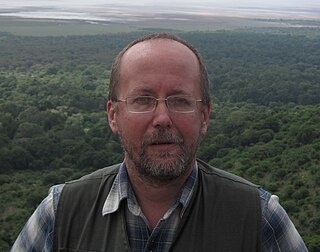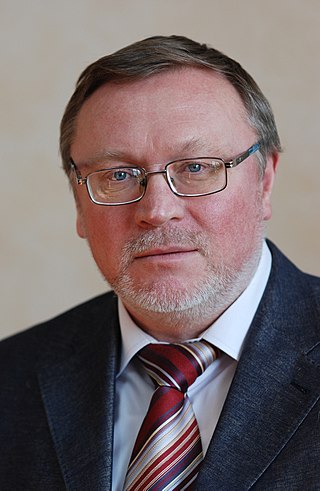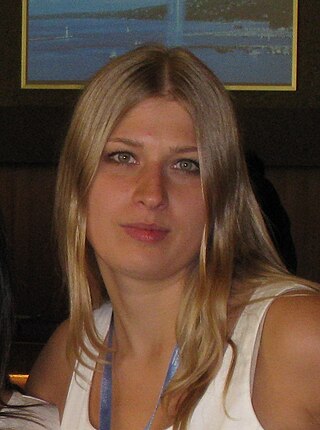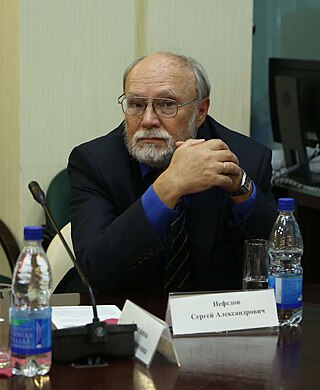Related Research Articles

In economics, Kondratiev waves are hypothesized cycle-like phenomena in the modern world economy. The phenomenon is closely connected with the technology life cycle.
In political science, a revolution is an attempt to achieve fundamental and relatively sudden change in political power and political organization. It typically involves a revolt against the government due to perceived oppression or political incompetence.
Nikolai Dmitriyevich Kondratiev was a Russian Soviet economist and proponent of the New Economic Policy (NEP) best known for the business cycle theory known as Kondratiev waves.
A chiefdom is a form of hierarchical political organization in non-industrial societies usually based on kinship, and in which formal leadership is monopolized by the legitimate senior members of select families or 'houses'. These elites form a political-ideological aristocracy relative to the general group.

Malthusianism is the theory that population growth is potentially exponential, according to the Malthusian growth model, while the growth of the food supply or other resources is linear, which eventually reduces living standards to the point of triggering a population decline. This event, called a Malthusian catastrophe occurs when population growth outpaces agricultural production, causing famine or war, resulting in poverty and depopulation. Such a catastrophe inevitably has the effect of forcing the population to "correct" back to a lower, more easily sustainable level. Malthusianism has been linked to a variety of political and social movements, but almost always refers to advocates of population control.

Social cycle theories are among the earliest social theories in sociology. Unlike the theory of social evolutionism, which views the evolution of society and human history as progressing in some new, unique direction(s), sociological cycle theory argues that events and stages of society and history generally repeat themselves in cycles. Such a theory does not necessarily imply that there cannot be any social progress. In the early theory of Sima Qian and the more recent theories of long-term ("secular") political-demographic cycles as well as in the Varnic theory of P.R. Sarkar, an explicit accounting is made of social progress.
Quantitative history is a method of historical research that uses quantitative, statistical and computer resources. It is considered a type of the social science history and has four major journals: Historical Methods, Journal of Interdisciplinary History, the Social Science History, and Cliodynamics: The Journal of Quantitative History and Cultural Evolution.

According to the Encyclopedia of International Development, the term demographic trap is used by demographers "to describe the combination of high fertility and declining mortality in developing countries, resulting in a period of high population growth rate (PGR)." High fertility combined with declining mortality happens when a developing country moves through the demographic transition of becoming developed.

Pre-industrial society refers to social attributes and forms of political and cultural organization that were prevalent before the advent of the Industrial Revolution, which occurred from 1750 to 1850. Pre-industrial refers to a time before there were machines and tools to help perform tasks en masse. Pre-industrial civilization dates back to centuries ago, but the main era known as the pre-industrial society occurred right before the industrial society. Pre-Industrial societies vary from region to region depending on the culture of a given area or history of social and political life. Europe was known for its feudal system and the Italian Renaissance.

Andrey Vitalievich Korotayev is a Russian anthropologist, economic historian, comparative political scientist, demographer and sociologist, with major contributions to world-systems theory, cross-cultural studies, Near Eastern history, Big History, and mathematical modelling of social and economic macrodynamics.
Jack A. Goldstone is an American sociologist, political scientist, and historian, specializing in studies of social movements, revolutions, political demography, and the 'Rise of the West' in world history. He is an author or editor of 13 books and over 150 research articles. He is recognized as one of the leading authorities on the study of revolutions and long-term social change. His work has made foundational contributions to the fields of cliodynamics, economic history and political demography. He was the first scholar to describe in detail and document the long-term cyclical relationship between global population cycles and cycles of political rebellion and revolution. He was also a core member of the "California school" in world history, which replaced the standard view of a dynamic West and stagnant East with a ‘late divergence’ model in which Eastern and Western civilizations underwent similar political and economic cycles until the 18th century, when Europe achieved the technical breakthroughs of industrialization. He is also one of the founding fathers of the emerging field of political demography, studying the impact of local, regional, and global population trends on international security and national politics.
Leonid Efimovich Grinin is a Russian philosopher of history, sociologist, political anthropologist, economist, and futurologist.

Peter Valentinovich Turchin is a Russian-American complexity scientist, specializing in an area of study he and his colleagues developed called cliodynamics—mathematical modeling and statistical analysis of the dynamics of historical societies. He is currently Editor-in-Chief at Cliodynamics: The Journal of Quantitative History and Cultural Evolution. As of 2020, he is a director of the Evolution Institute.

Nikolay Nikolaevich Kradin is a Russian anthropologist and archaeologist. Since 1985 he has been a Research Fellow of the Institute of History, Archaeology and Ethnology, Far East Branch of the Russian Academy of Sciences in Vladivostok. He was Head and Professor of the Department of Social Anthropology in the Far-Eastern National Technical University, and also Head and Professor of the Department of World History, Archaeology and Anthropology in the Far-Eastern Federal University. Corresponding Member of the Russian Academy of Sciences since 2011 and full Member of the Russian Academy of Sciences since 2022.
Cliodynamics is a transdisciplinary area of research that integrates cultural evolution, economic history/cliometrics, macrosociology, the mathematical modeling of historical processes during the longue durée, and the construction and analysis of historical databases.
A world-system is a socioeconomic system, under systems theory, that encompasses part or all of the globe, detailing the aggregate structural result of the sum of the interactions between polities. World-systems are usually larger than single states, but do not have to be global. The Westphalian System is the preeminent world-system operating in the contemporary world, denoting the system of sovereign states and nation-states produced by the Westphalian Treaties in 1648. Several world-systems can coexist, provided that they have little or no interaction with one another. Where such interactions becomes significant, separate world-systems merge into a new, larger world-system. Through the process of globalization, the modern world has reached the state of one dominant world-system, but in human history there have been periods where separate world-systems existed simultaneously, according to Janet Abu-Lughod. The most well-known version of the world-system approach has been developed by Immanuel Wallerstein. A world-system is a crucial element of the world-system theory, a multidisciplinary, macro-scale approach to world history and social change.

Daria Andreyevna Khaltourina is a Russian sociologist, anthropologist, demographer, and a public figure. She is the head of the Group of the Monitoring of Global and Regional Risks of the Russian Academy of Sciences, co-chairperson of the Russian Coalition for Alcohol Control, as well as the Russian Coalition for Tobacco Control. She is a laureate of the Russian Science Support Foundation Award in "The Best Economists of the Russian Academy of Sciences" nomination (2006).
Historical dynamics broadly includes the scientific modeling of history. This might also be termed computer modeling of history, historical simulation, or simulation of history - allowing for an extensive range of techniques in simulation and estimation. Historical dynamics does not exist as a separate science, but there are individual efforts such as long range planning, population modeling, economic forecasting, demographics, global modeling, country modeling, regional planning, urban planning and many others in the general categories of computer modeling, planning, forecasting, and simulations.

Elite overproduction is a concept developed by Peter Turchin, which describes the condition of a society which is producing too many potential elite members relative to its ability to absorb them into the power structure. This, he hypothesizes, is a cause for social instability, as those left out of power feel aggrieved by their relatively low socioeconomic status.

Sergey Aleksandrovich Nefedov is a Russian historian, Doctor of Sciences in Historical Sciences (2007), Candidate of Sciences in physico-mathematical sciences (1981), leading researcher at the Institute of History and Archaeology of the Ural branch of the Russian Academy of Sciences. He also is a professor at the Ural Federal University.
References
- ↑ Goldstone, Jack A. (1983). "Capitalist Origins of the English Revolution: Chasing a Chimera". Theory and Society. 12 (12): 143–180. doi:10.1007/BF00157010.
- ↑ Goldstone, Jack A. (1991). Revolution and Rebellion in the Early Modern World. Berkeley: University of California Press.
- ↑ Turchin, Peter; Nefedov, Sergey A. (2009). Secular Cycles. Princeton: Princeton University Press.
- ↑ Turchin, Peter (2016). Ages of Discord: A Structural-Demographic Analysis of American History. Chaplin, CT: Beresta Books.
- ↑ Grinin, Leonid E.; Korotayev, Andrey V. (2015). Great Divergence and Great Convergence: A Global Perspective. New York: Springer.
- ↑ Turchin, Peter (2013). "Modeling Social Pressures toward Political Instability". Cliodynamics. 4 (2): 241–280.
- ↑ Turchin, Peter; Gavrilets, Sergey; Goldstone, Jack A. (2017). "Linking 'Micro' to 'Macro' Models of State Breakdown: Improving Methods for Political Forecasting". Cliodynamics. 8 (2): 159–181.
- ↑ Turchin, Peter (2013). "Modeling Social Pressures toward Political Instability". Cliodynamics. 4 (2): 241–280.
- ↑ Goldstone, Jack A. (2017). "Demographic Structural Theory: 25 Years On". Cliodynamics. 8 (2): 85–112.
- ↑ Korotayev, A.; et al. (2011). "A Trap At The Escape From The Trap? Demographic-Structural Factors of Political Instability in Modern Africa and West Asia". Cliodynamics. 2/2: 1–28.
- ↑ Korotayev, A., Malkov, S., & Grinin, L. (2014). A trap at the escape from the trap? Some demographic structural factors of political instability in modernizing social systems. History & Mathematics, 4, 201-267 (link to www.academia.edu).